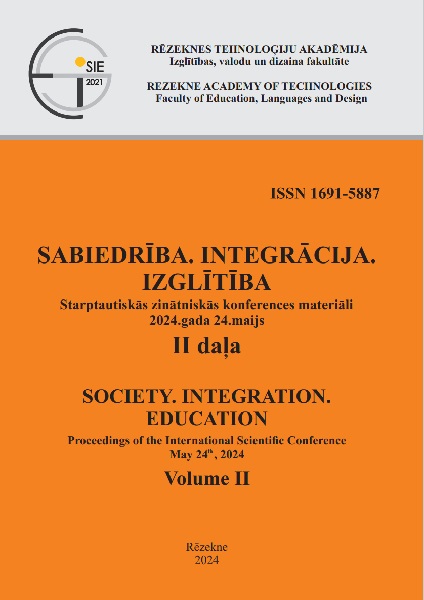QUALITY OF DISTANCE LEARNING IN SECONDARY SCHOOL SPORTS AND HEALTH CLASSES
DOI:
https://doi.org/10.17770/sie2024vol2.7792Keywords:
quality of distance learning, secondary school, sports and health classesAbstract
Distance learning or remote studies can break the boundaries of time and space, as students can use computers or electronic devices (for instance, mobile phones and tablets) to instantly acquire learning resources and listen to teachers during remote classes. The pandemic led to procedures that changed the way teachers teach and communicate with students and families. All teachers faced such a situation for the first time, thus it was necessary to invent, acquire and apply new teaching methods in sports and health classes, in order to provide students with the planned amount of physical activity in sports classes, as well as to implement the curriculum. The human body is made for movement; therefore, a person feels best when they move regularly. The aim of this study was to evaluate the skills of sports teachers to apply digital teaching methods in secondary school sports and health classes, and the quality of distance learning. Research methods: the research used surveys, which were issued to 29 secondary schools in Latvia, as well as to 2 respondents from primary schools. In total, 34 respondents filled out the research survey. In order to determine the opinion of sports teachers on the quality of distance learning in sports classes in secondary school and the applied digital skills, interviews were conducted with the participation of 5 sports teachers. Analysing the responses to the survey and the correlations between them, the research results show that if the sports teacher has not acquired digital skills, then online and distance learning cannot be provided, as well as the set learning results in sports in secondary school are not achieved.
References
Baena-Morales, S., López-Morales, J. un García-Taibo, O. (2020). La intervención docente en educación física durante el periodo de cuarentena por covid-19 (teaching intervention in physical education during quarantine for covid-19). Retos, 39 , 388–395. Retrieved from https://recyt.fecyt.es/index.php/retos/article/view/80089
Baldiņš, A. (2017). E-pedagoģijas satura pilnveide. Retrieved from file:///C:/Users/Dell/Downloads/04_Baldins_41-50.pdf
Daniela, L., Rūdolfa, A. (2019). Learning Platforms: How to Make the Right Choice. In: Daniela, L. (eds) Didactics of Smart Pedagogy. Springer, Cham. DOI: https://doi.org/10.1007/978-3-030-01551-0_10
Dudley, D., Mackenzie, E., van Bergen, P., Cairney, J., & Barnett, L. (2022). What Drives Quality Physical Education? A Systematic Review and Meta-Analysis of Learning and Development Effects From Physical Education-Based Interventions. In Frontiers in Psychology (Vol. 13). https://doi.org/10.3389/fpsyg.2022.799330
Heather, G. ( 2020). Integrating physical activity into distance education. Retrieved from https://today.tamu.edu/2020/04/08/integrating-physical-activity-into-distance-education/
Jansone, R., Fernāte, A., & Immere, I. (2014). Learning Outcomes Approach Implementation: Future Physical Education Teachers’ Didactic Competence Assessment. In Society. Integration. Education. Proceedings of the International Scientific Conference (Vol. 3, pp. 424-433).
Jeong, H.C., So, W.Y. (2020). Difficulties of online physical education classes in middle and high school and an efficient operation plan to address them. International Journal of Environmental Research and Public Health nt, 17(19), 7279 https://doi.org/10.3390/ijerph17197279
Karaca, Y., Kalayci. M.,C. (2021). Sports Activities in the Covid-19 Pandemic Process. Int J Life Sci Pharma Res. ISSN 2250-0480; SP-14; “Health and Sports Sciences-2021”. Retrieved from https://www.researchgate.net/publication/349521876_Sports_Activities_in_the_Covid-19_Pandemic_Process
Korcz, A. (2020). Physical education teachers’ opinion about online teaching during the covid-19 pandemic—comparative study of European countries. Sustainability 2021, 13(21), 11730; https://doi.org/10.3390/su132111730
López-Fernández, I., Burgueño,R., Gil-Espinosa, F.,J. (2021). High school physical education teachers’ perceptions of blended learning one year after the onset of the Covid-19 pandemic. Int J Environ Res Public Health. 2021 Nov; 18(21): 11146. doi: 10.3390/ijerph182111146
Mercier ,K., Centeio, E., Garn ,A., Erwin,H., Marttinen ,R., Foley, J. (2021). Physical education teachers’ experiences with remote instruction during the initial phase of the covid-19 pandemic. Journal of Teaching in Physical Education, 40 (2), 337–342. DOI: https://doi.org/10.1123/jtpe.2020-0272
Morgan, H. (2020). Best Practices for Implementing Remote Learning during a Pandemic. The Clearing House: A Journal of Educational Strategies, Issues and Ideas 93 (3), 135-141. DOI: https://doi.org/10.1080/00098655.2020.1751480
Nieman, D.,C. (2020) Coronavirus disease-2019: a tocsin to our aging, unfit, corpulent, and immunodeficient society. Journal of Sport and Health Science, 9 (4), 293-301. DIO: https://doi.org/10.1016/j.jshs.2020.05.001
Richards, K.,A.,R., Gaudreault, K,.L., Starck, J.,R., Woods, A.,M. (2018). Physical education teachers’ perceptions of perceived mattering and marginalization. Physical Education and Sport Pedagogy, 23 (4), 445-459. DIO: https://doi.org/10.1080/17408989.2018.1455820
Salama, R., Uzunboylu, H., Alkaddah, B. (2020). Distance learning system, learning programming languages by using mobile applications. New Trends and Issues. Proceedings on Humanities and Social Sciences, 23–47 p.
Šišlova, E., & Fernāte, A. (2018). Previous Experience of University Students in Physical Education at High School. In Society. Integration. Education. Proceedings of the International Scientific Conference. Retrieved from https://doi.org/10.17770/sie2018vol1.3415
Väätäjä, J. O., & Ruokamo, H. (2021). Conceptualizing dimensions and a model for digital pedagogy. In Journal of Pacific Rim Psychology (Vol. 15). https://doi.org/10.1177/1834490921995395
Valsts izglītības satura centrs [National Centre for Education (NCE)] (2021). Vadlīnijas klātienes, kombinētu un attālinātu mācību īstenošanai: metodiski ieteikumi vispārējās un profesionālās izglītības iestādēm COVID-19 izplatības laikā. Retrieved from: https://skola2030.lv/admin/filemanager/files/2/Vadlinijas%20attalinatam%20macibam_31032021.pdf
Valsts izglītības satura centrs [National Centre for Education (NCE)] (2020). Vadlīnijas vispārējās un profesionālās izglītības iestādēm attālinātu mācību īstenošanai. Retrieved from https://www.visc.gov.lv/lv/media/19005/download?attachment
Varea, V., González-Calvo, G., & García-Monge, A. (2022). Exploring the changes of physical education in the age of Covid-19. Physical Education and Sport Pedagogy, 27(1) 32-42. https://doi.org/10.1080/17408989.2020.1861233
Vossensteyn, H., Kaiser F., Jovaišas, K., Bolinskis, G., Kovaļevskis, K., Jongbloaed, B., Gumuliauskas, R., & Redko, A. (2019). Starpziņojums par jēdziena “izglītības kvalitāte” definīciju un to raksturojošiem kvalitatīvajiem un kvantitatīvajiem rādītājiem. UAB “Civitta”. Retrieved from https://www.izm.gov.lv/lv/media/4717/download
WHO, IFRC, & Unicef. (2020). Key Messages and Actions for Prevention and Control in Schools. Key Messages and Actions for COVID-19 Prevention and Control in Schools, March. Retrieved from https://www.who.int/publications/m/item/key-messages-and-actions-for-covid-19-prevention-and-control-in-schools






